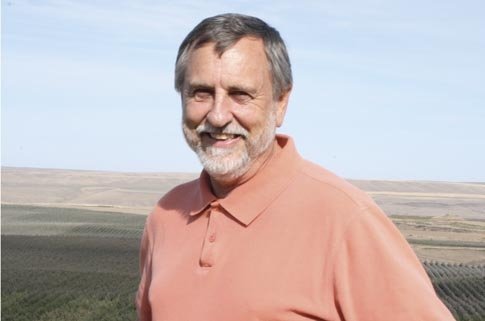
Ralph Broetje’s interest in new apple varieties has never waned. He was among the first Washington growers to plant Granny Smith and, by 1990, was producing almost a quarter of Washington State’s Granny Smith crop, as well as most of the state’s Galas.
Broetje now has more than 5,000 acres of apples at his Prescott ranch on the Snake River in Washington, plus 500 acres to the north at Benton City, and a 675-acre organic orchard further south at Wallula.
Most of his recent plantings are on vertical trellis systems, with trees five feet apart and 13 feet between rows. They consistently produce 80 to 100 bins per acre.
Varieties include Fuji, Gala, Braeburn, Red and Golden Delicious, Pink Lady, and Honeycrisp, along with lesser-known and experimental varieties. Granny Smith is still his number-one variety in terms of volume, but he’s looking for varieties that mature in early or mid-season and will reduce his labor needs late in the fall.
“I’m constantly looking for the next good variety that might show up,” he said. “That’s part of the fun of growing apples—there’s always something new coming out, and it’s fun to keep trying them. My goal is to find better varieties, just more varieties for the consumer to choose from and have a better eating experience.”
Honeycrisp
Broetje planted his first Honeycrisp trees in 1991, before the variety became popular, but the first couple of years the trees produced big, ugly apples that had bitter pit. He promptly grafted them over to Fuji.
“Luckily, some of the grafts didn’t take, and there were a few limbs of Honeycrisp that made it,” he said. “When the trees settled down, the fruit was pretty nice. I went out and grabbed a few to eat, and it was amazing.”
He ended up with a couple of bins, which he took to a local grocery store. The store quickly sold out and asked for more.
“We started planting Honeycrisp, but we missed about six or seven years there,” he laments.
He turned down the opportunity to grow the New Zealand club variety Jazz because ENZA specifies that the fruit must go to certain packers and he prefers to pack his own fruit.
“I think it’s a really good opportunity for growers who don’t have their own packing house,” he said. “They should get a good return each year for a long time, with the restricted production on it.”
Broetje is now interested in a new, yellow apple called Luna from the Czech Republic that he’s been offered an exclusive U.S. license on. He hopes to grow it organically because it doesn’t bruise, maintains its flavor, and can be stored well without MCP (1-methylcyclopropene).
Organic
About 400 acres of his Prescott orchard are in transition to organic and will be certified next year. Along with the fruit from his organic orchard at Wallula, he will have enough organic fruit to justify a dedicated organic packing line. He’s looking at either adding a line or running one of the existing lines on a double shift to free up another for organic. His goal is to have 20 percent of his production organic eventually.
Broetje Orchards was among the first fruit grower-packers to be certified both under Safe Quality Food (SQF) 1000, which covers food-safety practices on the farm, and SQF 2000, which covers warehouse practices. Broetje would also like to be certified through SQF for social responsibility, which he is particularly interested in.
He believes that working on the certification process and going through annual audits would help the company do a better job in that area. “There’s some money involved and a lot of time involved, but it would help us treat people better, treat the environment better, and become better stewards of everything that’s been placed in our hands—and return the land in at least as good a shape if not better shape than we got it. I think it’s important to take the time and effort to do that. How much of that will be of interest to consumers versus organic is hard to tell.”

Leave A Comment